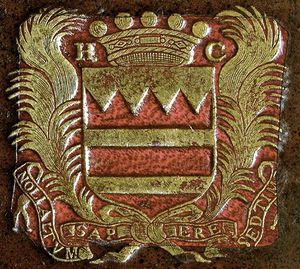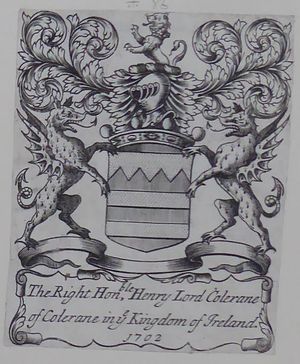Difference between revisions of "Henry Hare 1636-1708"
From Book Owners Online
(→Books) |
|||
| (7 intermediate revisions by 2 users not shown) | |||
| Line 1: | Line 1: | ||
__NOTITLE__ | __NOTITLE__ | ||
===[[name::Henry]] [[name::HARE]], 2nd [[personal title::Baron Coleraine]] [[date of birth::1636]]-[[date of death::1708]]=== | ===[[name::Henry]] [[name::HARE]], 2nd [[personal title::Baron Coleraine]] [[date of birth::1636]]-[[date of death::1708]]=== | ||
| − | [[File:HareHenry1.jpg| thumb | + | [[File:HareHenry1.jpg| thumb | Armorial stamp of Henry Hare (British Armorial Bindings) ]] |
| + | [[file:P1120405(2).JPG|thumb|The bookplate of Henry Hare (British Museum Franks Collection *86)]] | ||
====Biographical Note==== | ====Biographical Note==== | ||
| − | Eldest son of [[family::Hugh Hare]], 1st | + | Eldest son of [[family::Hugh Hare]], 1st Baron Coleraine (1605/6-1667). [[occupation::Deputy lieutenant of Wiltshire]] and gentleman of the privy chamber in 1668. [[occupation::MP]] for [[location::Old Sarum]] in 1679. An [[occupation::antiquary]], he collected medals and authored [[book title::''The history and antiquities of the town and church of Tottenham'']] ([[date of publication::1705]]). He [[bequest::left]] [[monetary value::£100]] for the repair of Tottenham church in his will, dated 1702. |
====Books==== | ====Books==== | ||
| − | Numerous books with | + | Numerous books with Hare's armorial stamp are known. He also used an engraved armorial bookplate (Franks 13740/*86). When his grandson, [[crossreference::Henry Hare 1693-1749]] 3rd Baron Coleraine, died without heirs in 1749, the family books were [[retail sale::sold]] in [[location of sale::London]], [[date of sale::1754]]. |
| + | |||
| + | ====Characteristic Markings==== | ||
| + | Hare's armorial stamp is usually applied on a red goatskin onlay, which enables the use of the correct heraldic tinctures. | ||
====Sources==== | ====Sources==== | ||
| Line 12: | Line 16: | ||
*[https://armorial.library.utoronto.ca/stamp-owners/HAR007 British Armorial Bindings]. | *[https://armorial.library.utoronto.ca/stamp-owners/HAR007 British Armorial Bindings]. | ||
*Doggett, Nicholas. [https://doi.org/10.1093/ref:odnb/12299 "Hare, Henry, second Baron Coleraine (bap. 1636, d. 1708), antiquary and architect."] ''Oxford Dictionary of National Biography''. | *Doggett, Nicholas. [https://doi.org/10.1093/ref:odnb/12299 "Hare, Henry, second Baron Coleraine (bap. 1636, d. 1708), antiquary and architect."] ''Oxford Dictionary of National Biography''. | ||
| + | *Gambier Howe, E. R. J. ''Franks bequest: catalogue of British and American book plates bequeathed to the ... British Museum''. London, 1903. | ||
</div> | </div> | ||
| Line 20: | Line 25: | ||
[[Category:Libraries Sold at Retail Sale]] | [[Category:Libraries Sold at Retail Sale]] | ||
[[Category:Armorial Stamps]] | [[Category:Armorial Stamps]] | ||
| + | [[Category:Bookplates and Labels]] | ||
| + | [[Category:All Owners]] | ||
Latest revision as of 01:59, 19 March 2024
Henry HARE, 2nd Baron Coleraine 1636-1708
Biographical Note
Eldest son of Hugh Hare, 1st Baron Coleraine (1605/6-1667). Deputy lieutenant of Wiltshire and gentleman of the privy chamber in 1668. MP for Old Sarum in 1679. An antiquary, he collected medals and authored The history and antiquities of the town and church of Tottenham (1705). He left £100 for the repair of Tottenham church in his will, dated 1702.
Books
Numerous books with Hare's armorial stamp are known. He also used an engraved armorial bookplate (Franks 13740/*86). When his grandson, Henry Hare 1693-1749 3rd Baron Coleraine, died without heirs in 1749, the family books were sold in London, 1754.
Characteristic Markings
Hare's armorial stamp is usually applied on a red goatskin onlay, which enables the use of the correct heraldic tinctures.
Sources
- British Armorial Bindings.
- Doggett, Nicholas. "Hare, Henry, second Baron Coleraine (bap. 1636, d. 1708), antiquary and architect." Oxford Dictionary of National Biography.
- Gambier Howe, E. R. J. Franks bequest: catalogue of British and American book plates bequeathed to the ... British Museum. London, 1903.

